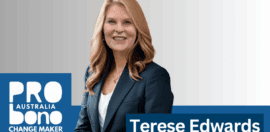Enabling the social sector to recognise and celebrate difference

8 December 2023 at 9:00 am
Two years ago, at the age of 61, Sharon was diagnosed as autistic. She is currently studying her 7th degree, a Masters in Autism, and is a “self-confessed workaholic”. Sharon identifies as a member of the “lost generation”, individuals who were not diagnosed as autistic when they were children. Sharon currently works with Community Capacity Builders, an organisation she founded to support community leaders and social entrepreneurs to address complex social, economic, and environmental problems through its research, programs, and advocacy.
Sharon is this weeks Pro Bono Australia change maker, read on to learn more about her passion for truly changing the future for autistic people in the workplace.
Describe your career trajectory and how you got to your current position.
The trajectory to my current position started back in 2001 when I received an Enterprising Woman of the Year Award for my work supporting community enterprises and community capacity building projects. After receiving the award, I was invited by organisations from very diverse sectors to speak at events. This was due to the Australian government having policies supporting social entrepreneurship and community capacity building at the time. Through engaging with these diverse sectors, I came to recognise five different sector approaches and two process approaches for building community capacity, and I started to identify concepts, tools, and techniques that contributed toward building community capacity from the seven approaches. I ended up identifying over 600 of these concepts, tools, and techniques, and then sorted them into a collaborative process that community members could follow to address any community issue or opportunity.
In 2005, I left the public sector so that I could work on my social enterprise Community Capacity Builders full time. Community Capacity Builders first product was a twenty-topic community leadership program that was based on the collaborative community capacity building process that I had developed. This program was piloted with community members in the City of Onkaparinga from 2006 to 2007. An evaluation of the pilot showed that the program had achieved its three target outcomes of participants creating community capacity building projects, bridging their projects to the strategic plans of governments, and engaging in community governance processes.
In 2008 I commenced a PhD so that I could track graduates from the program to determine the impact of the program on their practice. A key finding from this study was that the graduates were unable to create systems change. To address this finding, I developed a model for tackling wicked problems in place-based communities that focused on transitioning systems. Embedded into this model were twenty-six characteristics from four complex systems leadership theories that create enabling conditions for system transitions, and ten characteristics that assist governments to support this adaptive way of working. In 2015 the social enterprise Wicked Lab developed a software tool that was underpinned by the model.
As a cofounder at Wicked Lab, I designed a range of other innovations including a Complex Systems Leadership Program, a Tool for Developing and Measuring the Results of Interventions, and a Systemic Innovation Lab Methodology that supports diverse stakeholders to address wicked problems. All of these innovations were developed using the same cognitive approach that I had used to develop the models underpinning Community Capacity Builders program and Wicked Lab’s software – being fully immersed in an area of interest, recognising useful pieces of information in that area of interest, seeing associations amongst these pieces of information, and then systemising a model based on the identified associations.
In March 2022 I was officially diagnosed as autistic, and I now realise that my approach to product development is underpinned by autistic cognitive skills and strengths. Since my diagnosis, I have been immersed in understanding how autistic individuals can harness their innate skills and strengths to develop social innovations and social enterprises, discovering concepts and techniques that support this effort, and identifying associations between these concepts and techniques. The systemised model that has emerged, in addition to focusing on a social innovation and social enterprise development approach that aligns with autistic skills and strengths, incorporates, and integrates, support for autistic social entrepreneurs from disability and social enterprise support organisations. To advance this autistic approach to social innovation and social enterprise development, Community Capacity Builders has established a Centre for Autistic Social Entrepreneurship that is developing a Program for Supporting Autistic Social Entrepreneurs and a Program for Mentoring Autistic Social Entrepreneurs.
What does this role mean to you?
I am passionate about the Centre for Autistic Social Entrepreneurship’s objectives and believe that my own experience can contribute towards their achievement. These objectives are:
- to reframe autistic cognition from its current deficit focus to an understanding that autistic cognition is different but by no means less, and
- to reframe how to address autistic unemployment from the current expectation that employers will make accommodations for autistic individuals, to enabling and supporting autistic individuals to design and control their own work environment.
Take us through a typical day of work for you.
I am usually in my home office by 9.00 am unless I have a meeting or I am presenting at a conference overseas during the night, then I start later. My days are generally spent researching, writing, and developing new products. If I am attending events or delivering training away from home my typical day is very different. I am directionally challenged and unable to use a GPS app as I have aphantasia (an absence of visual imagery), so I have to spend a lot of time scoping out and recording how to get to where I need to go. Due to sensory challenges, I also block out recovery time after events.
What is the biggest challenge you’ve encountered in your career, and how did you overcome it?
The biggest challenge I have encountered is the relentless pressure to mask that I am autistic. There is constant pressure to conform – to work with information, participate in conversations, switch between tasks, and have sensory experiences as if I am not autistic.
Masking takes up a huge amount of energy and has a devastating impact on mental health. Recent research has shown that autistic individuals are seven times more likely to die by suicide than non-autistic people, and the defeat and entrapment autistic individuals constantly feel from having to mask their autistic traits so that they can fit into the neurotypical world is a significant contributing factor. Research has also shown that masking dampens natural autistic strengths and skills.
Unfortunately, I have not overcome this challenge. Only recently I was told when expressing my need for accommodations, that my autism impacts negatively on people who are not autistic. I am not alone in having my needs disregarded like this. Commissioner Rhonda Galbally commented at the Disability Royal Commission closing ceremony that there were fears in the Australian community that disability is infecting and interfering with the lives of non-disabled people.
If you could go back in time, what piece of advice would you give yourself as you first embarked on your career?
My advice would be, Sharon find out how your brain works. I left school when I was very young and struggled in the few employment positions that I had before becoming self-employed. If I had been aware that my brain worked differently to how I was being taught at school and to how I was expected to work, I would have found my own way to learn and would have become self-employed a lot earlier.
How do you unwind after work?
When working from home, I have no need to unwind at the end of the day as work is relaxing. Autistic individuals who are able to work on their interests in the right environment, can work in a flow state which is an enjoyable, fulfilling, and focussed state where you lose a sense of self and what is going on around you. When I had my autism diagnosis, I was told that the reason I had been so successful as an autistic person is because I had been able to control my work environment.
What was the last thing you watched, read or listened to?
The last audiobook I listened to was “The Autism Industrial Complex: How Branding, Marketing, and Capital Investment Turned Autism into Big Business”. The book situates autism as a commodity in a multi-billion dollar a year industry, and provides insights into how human greed makes it difficult to transition from autistic people being viewed as deficient to recognising the unique skills and strengths that autistic people have.







